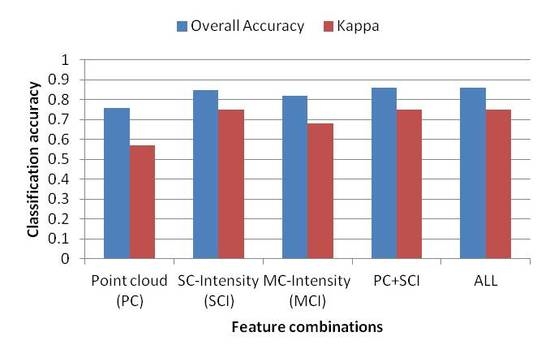1
Finnish Geospatial Research Institute, National Land Survey, Geodeetinrinne 2, FI-02430 Masala, Finland
2
Department of Forest Sciences, University of Helsinki, FI-00014 Helsinki, Finland
*
Author to whom correspondence should be addressed.
Received: 20 October 2016 / Accepted: 20 January 2017 / Published: 27 January 2017
Abstract
This paper investigated the potential of multispectral airborne laser scanning (ALS) data for individual tree detection and tree species classification. The aim was to develop a single-sensorsolution for forest mapping that is capable of providing species-specific information, required for forest management and planning purposes. Experiments were conducted using 1903 ground measured trees from 22 sample plots and multispectral ALS data, acquired with an Optech Titan scanner over a boreal forest, mainly consisting of Scots pine (Pinus Sylvestris), Norway spruce (Picea Abies), and birch (Betula sp.), in southern Finland. ALS-features used as predictors for tree species were extracted from segmented tree objects and used in random forest classification. Different combinations of features, including point cloud features, and intensity features of single and multiple channels, were tested. Among the field-measured trees, 61.3% were correctly detected. The best overall accuracy (OA) of tree species classification achieved for correctly-detected trees was 85.9% (Kappa = 0.75), using a point cloud and single-channel intensity features combination, which was not significantly different from the ones that were obtained either using all features (OA = 85.6%, Kappa = 0.75), or single-channel intensity features alone (OA = 85.4%, Kappa = 0.75). Point cloud features alone achieved the lowest accuracy, with an OA of 76.0%. Field-measured trees were also divided into four categories. An examination of the classification accuracy for four categories of trees showed that isolated and dominant trees can be detected with a detection rate of 91.9%, and classified with a high overall accuracy of 90.5%. The corresponding detection rate and accuracy were 81.5% and 89.8% for a group of trees, 26.4% and 79.1% for trees next to a larger tree, and 7.2% and 53.9% for trees situated under a larger tree, respectively. The results suggest that Channel 2 (1064 nm) contains more information for separating pine, spruce, and birch, followed by channel 1 (1550 nm) and channel 3 (532 nm) with an overall accuracy of 81.9%, 78.3%, and 69.1%, respectively. Our results indicate that the use of multispectral ALS data has great potential to lead to a single-sensor solution for forest mapping. View Full-Text
Keywords: multispectral laser scanning; ALS; individual tree detection; tree species classification; random forest
▼ Figures
This is an open access article distributed under the Creative Commons Attribution License which permits unrestricted use, distribution, and reproduction in any medium, provided the original work is properly cited. (CC BY 4.0).
For further details log on website :
http://www.mdpi.com/2072-4292/9/2/108?utm_source=TrendMD&utm_medium=cpc&utm_campaign=Remote_Sens_TrendMD_0






No comments:
Post a Comment